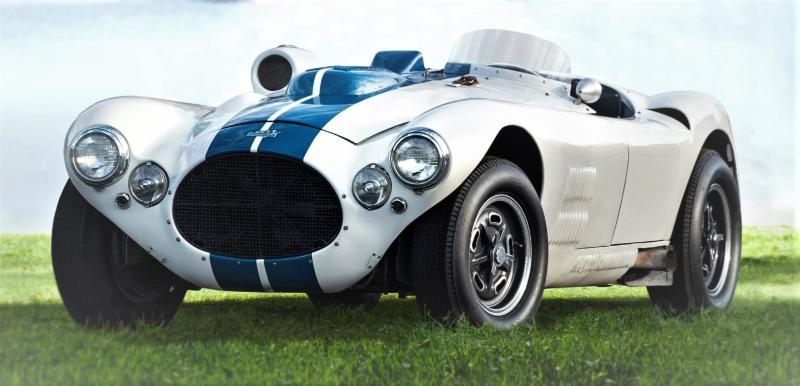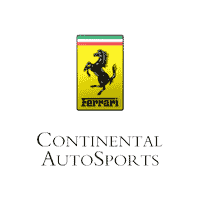Once Upon A Wire Wheel
The following is the second in a series of articles recalling highlights from the Region’s beginnings through the first 50 years. This was written by Bernie & Norm Koglin with input from Fred Wacker, Bud Seaverns, and Burdie Martin to name a few. Look for more articles though out the year. Have fun exploring the past and how it relates to now.

The Road America Era Begins *1955 – 1960
Road racing was catching on. Spectator interest was increasing, and more and faster cars were appearing at every event. In the early ’50’s several race-related spectator injuries occurred at public-road races (not Elkhart Lake). This soon resulted in a U.S. moratorium on street racing that continued for about twenty years. Racing continued on a few closed circuits and on airport courses. Air Force General Curtis LeMay should be remembered for making a number of air bases available for races during this difficult time.
No matter how improbable, in 1955 a four-mile road race course was completed in a small Wisconsin resort town. This was almost entirely due to the efforts of one man. Clif Tufte was a resident of Elkhart Lake and the owner of a gravel pit business outside of town. Envisioning the potential of road racing, he gained the support of the community, local business people, and the Chicago Region. With only about one-half the necessary funding in hand, he began construction in 1954 and the facility was completed in time for a September 9, 1955 National race.
An “ELKHART PROGRESS REPORT” appeared in the August issue of Piston Patter and included the following:
“We attended a stockholders’ meeting recently and looked over the Road America course. By this time it is a safe guess that the course is completely paved. The paving that we drove over is superb – not as slick as most blacktop highways and not as rough as most airports. A fine surface with good traction, without too much friction.
The Race Committee also attended this meeting; and, among other things, measured the track. The one lap distance according to F.I.A. specifications is four (4) miles right on the nose.”
Today’s race workers might be interested in the following segment of the worker recruiting article that also appeared in the August issue”…The officials have realized that since the program is so big, the fair and pleasant thing to do is work up a watch and station bill. What this amounts to is that a volunteer will have a certain specified time for work, and an equal time for relaxing and spectating …”
In these early years it was not unusual for racers to travel great distances to participate in the few premier race events at better courses such as Road America and Watkins Glen. So it is not surprising to read that Briggs Cunningham intended to bring five cars to the Road America inaugural and that John Von Neumann planned to come from California. Suffice it to say that the race was a success.
But do not be led to believe that Road America was the only interest and activity of the Region and its members during 1955. There were races and a drivers’ school at Wilmot Raceway. Several rallies were scheduled, including one combined with a picnic, a loop rally and the two-day, 1,000 mile, Lake Michigan Miglia rally. This grueling, around-the-lake event was won by a then-new member named Dave Morrell, driving a VW Beetle. Dave went on to become one of our more illustrious members. He held any number of Chicago Region positions, including RE. Later, he became Chairman of the Board of SCCA, and before his untimely death, he was awarded the Woolf Barnato trophy, the highest honor SCCA can bestow.
In the June, 1955 Piston Patter, it was noted that the membership was more than 250.
Wilmot was not on the schedule in 1956, but in addition to the June National races, a Road America weekend of endurance races was included. Jim Kimberly won the four- hour Saturday enduro, co-driving an Osca with Carrol Shelby. Jim, a Chicago Region member, was elected national president of SCCA at the annual meeting of the Club in February, 1956. Other drivers of note on Saturday included Lance Reventlow co-driving with Ritchie Ginther. On Sunday a six-hour race was won by J.A. Kilbourn, driving a Ferrari. He finished ahead of the Briggs Cunningham/John Fitch D Jaguar, the Paul O’Shea/Phil Hill Mercedes Benz, and (not to mention) the Paul Antwerpen/Bud Seaverns Mercedes Benz. The Cook County 120 again included a rally and hill climb, with a number of entrants competing in both events. 77 teams entered and ran the 1956 Michigan Miglia. At the SCCA annual meeting Chicago received the Regional Achievement Award for 1955, with Chuck West, RE.
The status of Road America/Chicago Region events during this era was extraordinary. For example the Concours d’Elegance conducted as part of the 1957 June Road America race weekend (and for several years thereafter) included awards such as “Her Brittanic Majesty’s Government Medal” presented in person by the British Consul General. There were also German, French and Italian government trophies presented by representatives of those nations. Jaguar North America and Saks Fifth Avenue presented awards as well. Janet Pilgrim, the first Playboy centerfold, participated in trophy presentations throughout the weekend.
Most events planned in 1957 were similar to the previous year’s events, except the September race was scheduled as the initial Road America 500. Phil Hill won and Carrol Shelby was second. This was the year that Wilmot Hills Road Racing Association was organized and the course rebuilt. In late fall, a drivers’ school and low-key race were the first of many Wilmot events put on over a period of fifteen years.
In 1958 Wilmot appears on the schedule with a drivers’ school and three race events. Most of the activities of recent years were also on the calendar at that time. And then there was Meadowdale. On State Route 31, outside of Dundee, the developer of the sub-division across the road constructed a three-mile race course. On September 13 – 14, 1958, the Chicago Region conducted the inaugural event, a Regional race. Seeding of the grounds was unsatisfactory or had not been done, and dust enveloped everything and everyone. Earth embankments lined much of the course and several turns did not offer escape roads. The weekend was tragically marred by a fatal accident during Race Three. Certainly one of the Region’s least memorable events. Chicago Region began a period of discussions and negotiations with the course owner regarding needed modifications and improvements. One of the advertised “features” of the track was an asphalt-paved, steep banked “Monsa Wall”. It turned out that the asphalt kept sliding down the inclined surface during the heat of a Midwest summer and constant repaving was required. Ultimately the “wall” was leveled and converted to a flat corner.
The specter of professionalism had been appearing on the SCCA scene for a couple of years. By 1958 it was apparent that survival of private, closed-circuit race courses would demand the spectator revenue that only racing for money could generate. Resistance to this reality was strong, and debate heated. In any case the “good old days” were coming to an end.
Calendars for 1959 and 1960 included almost all of the 1958 events. Considering the conditions encoun-tered in 1958, it is not surprising that there were no races scheduled for Meadowdale. 1960 was the year that SCCA began classifying production cars on the basis of performance potential, rather than displacement. As one might expect, drivers whose cars had been superior under the displacement system were not enthusiastic about the change. Nevertheless, the classifications held up pretty well through the years, some still do to this day.
As the Region entered the 60’s, professional road racing was on the horizon. In addition, changing the car classification system made more cars competitive. This would generate more classes and open the way for more members to become drivers. Many changes were on the way!
Editor’s Note:
These articles end in 1989. If any one out there would like to put pen to paper with interesting facts from the years 1990-1999 & 2000-2018 we would very much appreciate them. Send your memories, facts or ramblings to: PegBall@Comcast.Net. Thanks!


